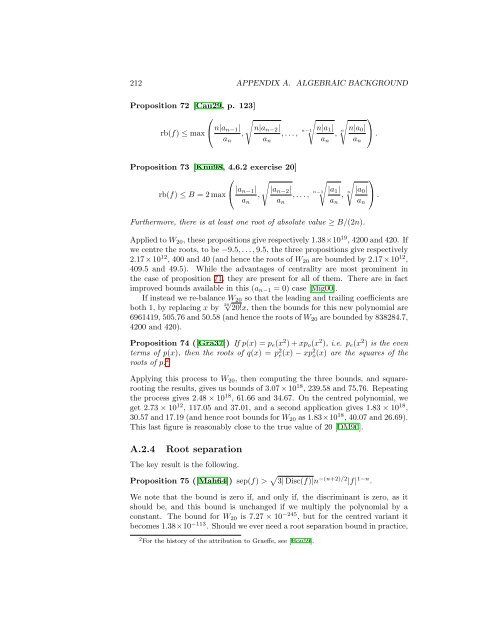Contents - Student subdomain for University of Bath
Contents - Student subdomain for University of Bath
Contents - Student subdomain for University of Bath
You also want an ePaper? Increase the reach of your titles
YUMPU automatically turns print PDFs into web optimized ePapers that Google loves.
212 APPENDIX A. ALGEBRAIC BACKGROUND<br />
Proposition 72 [Cau29, p. 123]<br />
⎛ √<br />
rb(f) ≤ max ⎝ n|a n−1|<br />
,<br />
a n<br />
√<br />
n|a n−2 |<br />
, . . . , n−1<br />
a n<br />
√<br />
n|a 1 |<br />
, n<br />
a n<br />
⎞<br />
n|a 0 |<br />
⎠ .<br />
a n<br />
Proposition 73 [Knu98, 4.6.2 exercise 20]<br />
⎛ √<br />
rb(f) ≤ B = 2 max ⎝ |a n−1|<br />
,<br />
a n<br />
√ √<br />
|a n−2 | |a<br />
, . . . , n−1 1 |<br />
, n<br />
a n<br />
a n<br />
Furthermore, there is at least one root <strong>of</strong> absolute value ≥ B/(2n).<br />
⎞<br />
|a 0 |<br />
⎠ .<br />
a n<br />
Applied to W 20 , these propositions give respectively 1.38×10 19 , 4200 and 420. If<br />
we centre the roots, to be −9.5, . . . , 9.5, the three propositions give respectively<br />
2.17 × 10 12 , 400 and 40 (and hence the roots <strong>of</strong> W 20 are bounded by 2.17 × 10 12 ,<br />
409.5 and 49.5). While the advantages <strong>of</strong> centrality are most prominent in<br />
the case <strong>of</strong> proposition 71, they are present <strong>for</strong> all <strong>of</strong> them. There are in fact<br />
improved bounds available in this (a n−1 = 0) case [Mig00].<br />
If instead we re-balance W 20 so that the leading and trailing coefficients are<br />
both 1, by replacing x by 20√ 20!x, then the bounds <strong>for</strong> this new polynomial are<br />
6961419, 505.76 and 50.58 (and hence the roots <strong>of</strong> W 20 are bounded by 838284.7,<br />
4200 and 420).<br />
Proposition 74 ([Gra37]) If p(x) = p e (x 2 ) + xp o (x 2 ), i.e. p e (x 2 ) is the even<br />
terms <strong>of</strong> p(x), then the roots <strong>of</strong> q(x) = p 2 e(x) − xp 2 o(x) are the squares <strong>of</strong> the<br />
roots <strong>of</strong> p. 2<br />
Applying this process to W 20 , then computing the three bounds, and squarerooting<br />
the results, gives us bounds <strong>of</strong> 3.07 × 10 18 , 239.58 and 75.76. Repeating<br />
the process gives 2.48 × 10 18 , 61.66 and 34.67. On the centred polynomial, we<br />
get 2.73 × 10 12 , 117.05 and 37.01, and a second application gives 1.83 × 10 18 ,<br />
30.57 and 17.19 (and hence root bounds <strong>for</strong> W 20 as 1.83×10 18 , 40.07 and 26.69).<br />
This last figure is reasonably close to the true value <strong>of</strong> 20 [DM90].<br />
A.2.4<br />
Root separation<br />
The key result is the following.<br />
Proposition 75 ([Mah64]) sep(f) > √ 3| Disc(f)|n −(n+2)/2 |f| 1−n .<br />
We note that the bound is zero if, and only if, the discriminant is zero, as it<br />
should be, and this bound is unchanged if we multiply the polynomial by a<br />
constant. The bound <strong>for</strong> W 20 is 7.27 × 10 −245 , but <strong>for</strong> the centred variant it<br />
becomes 1.38×10 −113 . Should we ever need a root separation bound in practice,<br />
2 For the history <strong>of</strong> the attribution to Graeffe, see [Hou59].












![[Luyben] Process Mod.. - Student subdomain for University of Bath](https://img.yumpu.com/26471077/1/171x260/luyben-process-mod-student-subdomain-for-university-of-bath.jpg?quality=85)



